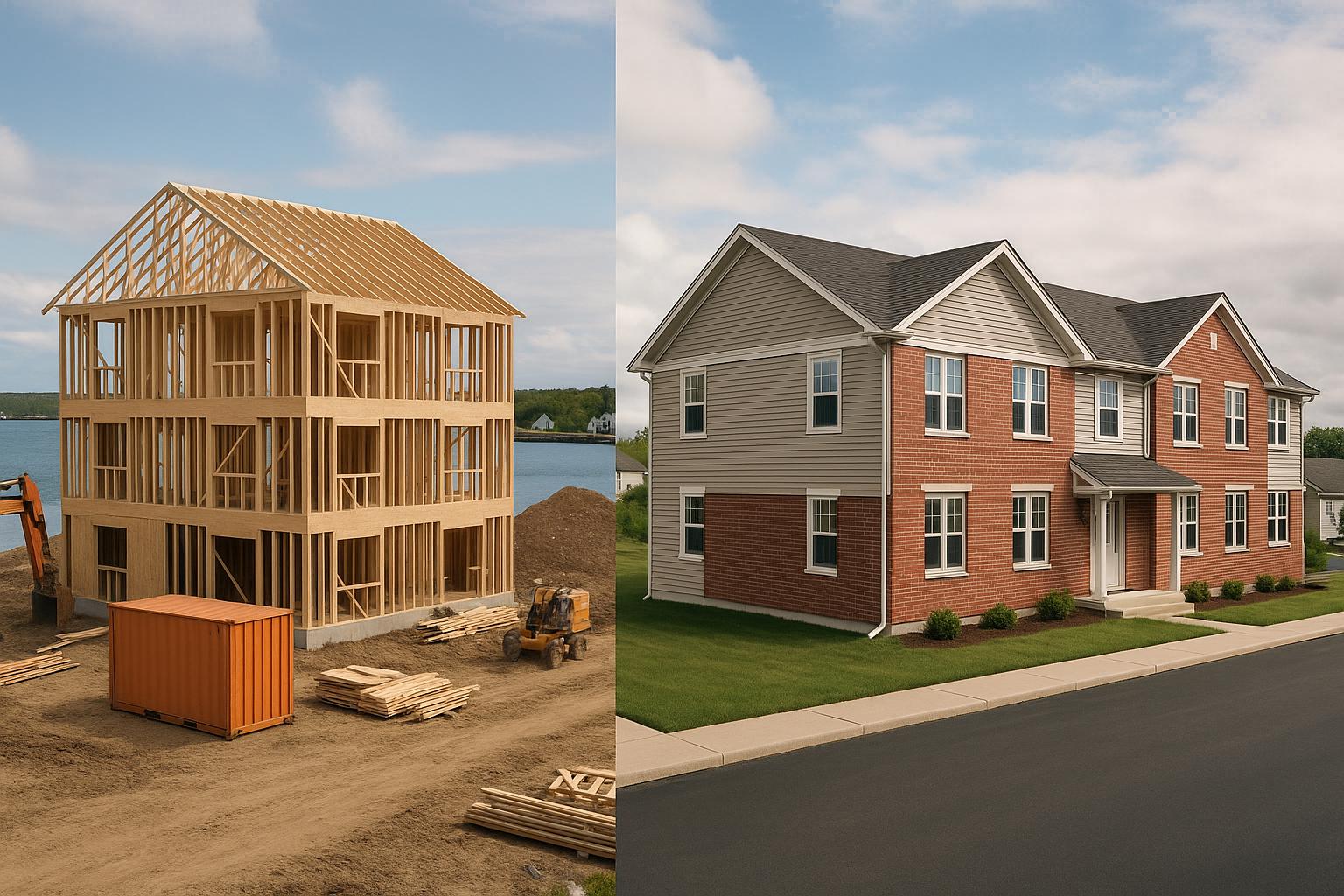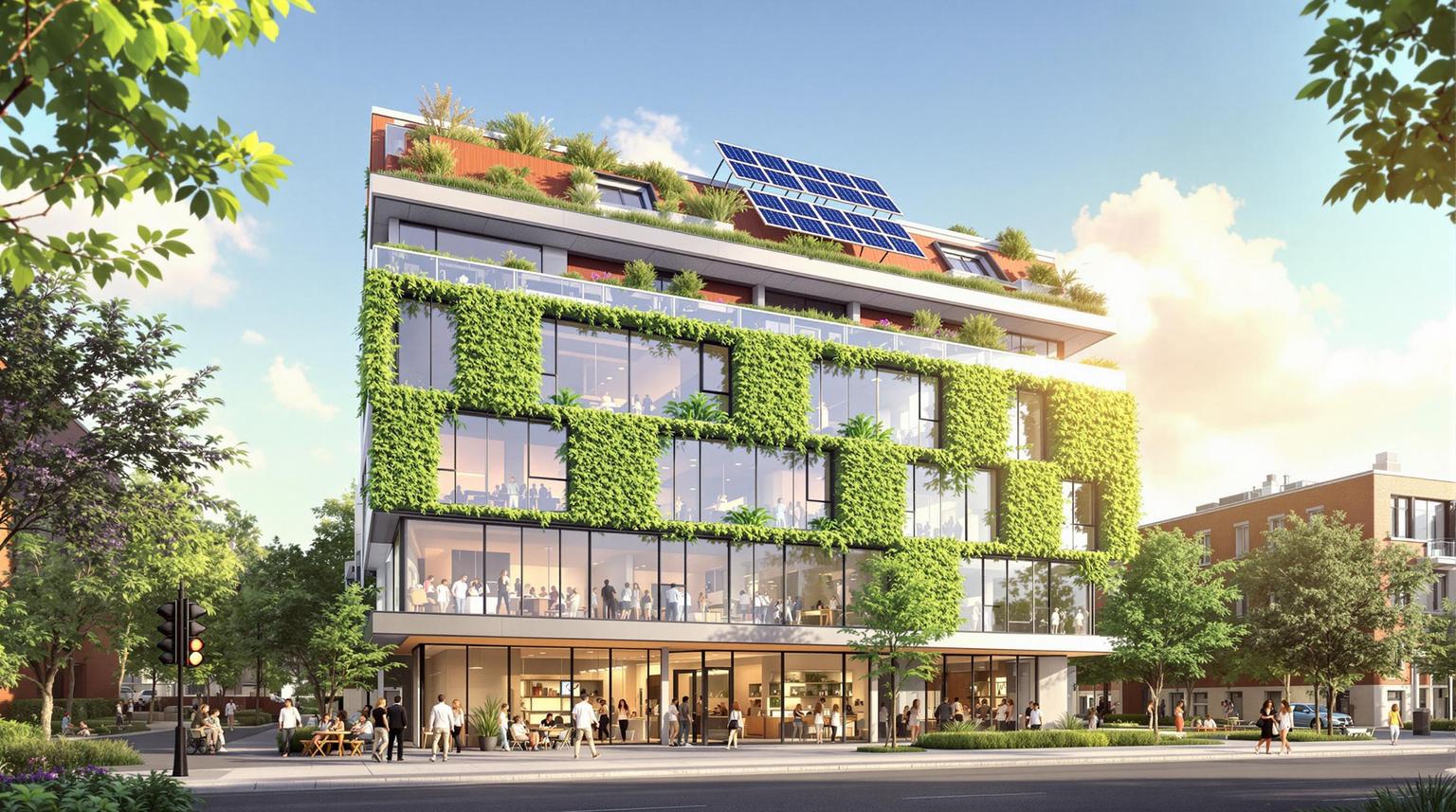Halifax's new 2025 zoning map introduces ER-3 zoning, allowing multi-unit housing on properties previously limited to single-family homes. This change opens opportunities for property owners to build up to three units - or more in some cases - on eligible lots, potentially increasing rental income. However, zoning rules include specific limits on height, setbacks, parking, and heritage area restrictions, making it essential to fully understand regulations before starting a project.
Key Takeaways:
- ER-3 zoning permits up to 3–8 units in certain areas, including secondary or backyard suites.
- Heritage Conservation Districts impose stricter limits, often allowing only one main dwelling and a secondary suite.
- Use Halifax's ExploreHRM tool to check your property's zoning status.
- Two-bedroom units tend to attract stable tenants and higher rents ($1,950–$2,100/month).
- Integrated design-build methods can save time, reduce costs, and minimize delays compared to traditional construction.
Act quickly to secure permits under current rules, as zoning laws can change. With Halifax's growing demand for rentals, ER-3 zoning offers a way to maximize property value while meeting housing needs.
How to Quickly Look Up Zoning in Halifax, Nova Scotia
What ER-3 Zoning Means for Halifax Property Owners
ER-3 zoning marks a shift in Halifax's residential development approach, moving beyond single-family homes to allow for more diverse housing options. This zoning designation makes room for small-scale, multi-unit developments, which not only address housing shortages but also provide property owners with opportunities for additional rental income. Below, we’ll break down the key aspects of ER-3 zoning to help you understand and make the most of your property’s potential.
ER-3 Zoning Basics
ER-3 zoning permits low-rise multi-unit housing, typically allowing for up to three units, such as townhomes or small apartment-style buildings. In some cases, specific sites may allow as many as eight units, depending on municipal regulations. This zoning is flexible, enabling a mix of housing types that can cater to market needs or site-specific conditions. Additionally, property owners can explore options like secondary or backyard suites, which can generate extra income.
Rules and Limits for ER-3 Properties
Developments under ER-3 zoning must adhere to Halifax's municipal planning standards, which are designed to preserve the character and quality of neighbourhoods. These standards cover various elements, including building height, setbacks, parking requirements, and lot coverage. The exact rules depend on the property’s location and unique circumstances, so consulting Halifax's planning department and official guidelines is crucial. If your property falls within a heritage area, additional considerations come into play.
Heritage District Rules
Properties located within Heritage Conservation Districts (HCDs) face stricter regulations compared to standard ER-3 zoning. In these areas, development rights are more limited. Typically, only a main dwelling and one secondary or backyard suite are permitted, regardless of the broader ER-3 allowances. Moreover, strict design and compatibility rules often lead to longer approval processes and higher costs.
For example, HCDs like Barrington Street and the Old South Suburb operate under older Downtown Halifax Plan policies rather than the newer Centre Plan regulations. This adds another layer of complexity for property owners trying to navigate their development options.
If your property is in an HCD, it’s important to act quickly. New heritage designations can further restrict ER-3 development opportunities.
How to Check if Your Property Qualifies for ER-3 Development
Wondering if your property is eligible for ER-3 development? Halifax Regional Municipality (HRM) provides an easy way to check. Here's how you can confirm your property's zoning status in just a few steps.
Using Halifax's Online Zoning Map
HRM has an interactive tool called ExploreHRM that makes it simple to find your property's zoning designation. Head over to the HRM website and access the ExploreHRM map. Once there, type in your address or community name, and the zoning information will appear. If your property is listed as ER-3, it qualifies for ER-3 development.
ER-3 zones are typically found in well-established neighbourhoods, along transit routes, and in areas that previously allowed townhomes. This includes a significant portion of downtown Halifax.
Building Profitable Rental Properties with ER-3 Rights
Once you’ve confirmed that your property qualifies for ER-3 development, the next step is crafting rental units that deliver strong returns. Halifax’s rental market provides plenty of opportunities for savvy property owners who approach construction with a clear plan.
Unit Layouts That Command Higher Rent
In Halifax, two-bedroom units consistently outperform other layouts in terms of rental income. To maximize returns, consider designing compact two-bedroom units with open-concept living areas, integrated storage, in-suite laundry, and energy-efficient features like triple-pane windows, ductless heat pumps, and proper insulation. These additions not only reduce utility costs but also help you attract tenants willing to pay premium rents ranging from $1,950 to $2,100 per month.
These units appeal to stable, long-term tenants who are more likely to stay compared to those renting bachelor or one-bedroom units. By streamlining the construction process, you can further enhance these benefits, as we’ll explore below.
The Advantage of Integrated Design-Build
Traditional construction methods, which rely on separate architects, engineers, and contractors, often lead to delays and increased costs. Coordination challenges between these fragmented teams can result in wasted time and money. When issues arise, professionals often shift blame, leaving property owners stuck in a frustrating cycle.
Integrated design-build companies, such as Helio Urban Development, simplify the process by consolidating all teams under a single contract. Instead of juggling multiple professionals, you work with one company that handles everything from design to construction.
This approach offers fixed pricing, so you know exactly what your project will cost. For example, Helio’s integrated model delivers construction at $160,000 per unit, with a guaranteed six-month timeline. This streamlined process ensures your project stays on track and within budget.
Comparing Integrated and Traditional Construction
The differences between these two approaches become strikingly clear when you look at actual outcomes for property owners.
With traditional construction, coordination issues often lead to cost overruns of 30–60% and delays that can stretch projects from eight months to over 18.
In contrast, integrated design-build eliminates these headaches by ensuring single-source accountability. When design, engineering, and construction teams collaborate from the start, they identify and resolve potential problems early, saving both time and money. Property owners benefit from daily photo updates and real-time project tracking via online portals.
Quality control is another key advantage. Integrated builders like Helio conduct professional engineering inspections throughout the process, ensuring consistent standards. This systematic approach includes a two-year warranty on all construction work, giving property owners peace of mind.
For those focused on rental income, timeline certainty is critical. Every month of construction delay for a four-unit building can cost you $8,800 in lost rental income. Integrated builders guarantee completion dates and even offer financial penalties - up to $1,000 per day - for delays, ensuring you can start collecting rent on schedule.
sbb-itb-16b8a48
Avoiding Common ER-3 Development Problems
Once you've explored ways to boost rental income, it's equally important to tackle the common challenges that can throw ER-3 projects off course. In Halifax, these projects often encounter obstacles that hinder progress. Property owners who anticipate these issues and address them early can save both time and money.
Preventing Cost Overruns and Construction Delays
Cost overruns and delays are common pitfalls in traditional construction projects, with budgets often exceeding initial estimates by 30–60% due to poorly coordinated teams. Opting for a fixed-price contract, such as an integrated design-build approach, can help avoid these issues. For example, a six-month timeline paired with a $1,000/day penalty for delays ensures accountability and minimizes the risk of lost rental income. By addressing these potential setbacks upfront, you set the stage for a smoother construction process.
Ensuring Long-Lasting, High-Quality Construction
Investing in quality construction not only reduces future maintenance expenses but also ensures steady rental income over time. When transforming homes into multi-unit rentals in ER-3 zones, meeting vital building code requirements - like fire separations, proper egress, and safe exits - is essential for both safety and compliance [1].
Choose builders who prioritize thorough quality checks. For instance, Helio Urban Development conducts five engineering inspections during construction, giving property owners the option to select the final inspector. A two-year warranty on construction work adds an extra layer of security, protecting your investment from premature repair costs. Additionally, energy-efficient upgrades - such as triple-pane windows, advanced insulation, and ductless heat pumps - can reduce operating costs while attracting tenants willing to pay higher rents. Beyond construction quality, solid project management practices can further streamline your development.
Simplifying the Management of Construction Professionals
Managing separate architects, engineers, and contractors can become a logistical headache, often leading to miscommunication, delays, and disputes. In traditional setups, property owners are left juggling multiple timelines and resolving conflicts between professionals - a process that can derail progress.
An integrated approach, where one company oversees the entire project, eliminates these coordination issues. This method can save property owners an average of $47,000 per project in coordination costs. Tools like daily photo updates and real-time project tracking through online platforms ensure transparency and allow for early issue detection. By working with a builder that offers single-source accountability, you can streamline design, engineering, and construction, keeping your project aligned with your goals and on schedule.
Next Steps for Your ER-3 Development Project
Getting started with your ER-3 development project requires a structured approach - no leaving things to chance. Here's how to move forward effectively, building on earlier advice about zoning, construction methods, and common pitfalls.
Verify your zoning. Begin by confirming your property’s ER-3 designation using Halifax's online zoning map. Most developments in the Halifax Regional Municipality (HRM) fall under "as-of-right" rules, meaning they comply with zoning regulations and only need a development permit - no discretionary approval from HRM Council [2]. For specific questions about how the Centre Plan applies to your property, reach out to HRM Planning & Development or email planhrm@halifax.ca [2]. Getting this clarity early will save you from unexpected (and costly) issues down the road.
Secure your development rights. Safeguard your project by ensuring all necessary approvals are in place under current by-laws. This includes an approved site plan, a density bonus agreement (if applicable), and both development and construction permits. You’ll want to act quickly - zoning rules can change, and having your permits locked in before any public hearing advertisement for new by-laws is crucial [2]. Acting promptly protects your investment and keeps your project on track.
Decide on your construction strategy. Opting for an integrated design-build approach can help avoid the coordination headaches and budget overruns that often arise when different construction professionals work independently. This streamlined method ensures smoother execution.
Prepare for immediate rental income. Investing in construction packages that include appliances and smart home features can set you up for faster returns. While this adds about $15,000 per unit upfront, it allows you to start generating rental income right away, which can significantly boost your cash flow.
Success in your ER-3 project hinges on understanding the rules, securing permits quickly, and working with reliable builders. With careful planning and execution, you’ll be well-positioned to take advantage of Halifax’s expanding rental market.
FAQs
How can Halifax property owners ensure their ER-3 development plans meet zoning rules, especially in Heritage Conservation Districts?
To make sure your ER-3 development plans align with Halifax's zoning regulations - particularly in Heritage Conservation Districts - you'll need to follow rules aimed at preserving the area's historical charm. These regulations often include restrictions on building heights, densities, and exterior changes to maintain the district's heritage value.
Start by exploring Halifax's official zoning maps and guidelines specific to ER-3 properties. If your project falls within a Heritage Conservation District, additional rules will likely apply. Reaching out to the Halifax Heritage Advisory Committee early in your planning can be incredibly helpful. They can offer advice on how to ensure your project supports local heritage preservation goals.
If any details are unclear, don’t hesitate to contact municipal planning officials or consult a heritage specialist. Their expertise can help confirm your plans meet both zoning and heritage requirements, making the approval process much smoother.
What are the benefits of using a design-build approach for ER-3 zoning projects in Halifax?
Why Choose a Design-Build Approach for ER-3 Zoning Projects in Halifax?
When it comes to developing multi-unit rental properties under ER-3 zoning in Halifax, the design-build method offers some clear advantages over traditional construction processes. By merging the design and construction phases into one seamless workflow, this approach can significantly speed up project timelines. It also helps avoid delays caused by miscommunication between separate teams, ensuring everything stays on track.
Another big benefit? You’ll have one point of accountability throughout the entire process. Instead of juggling multiple contracts and contractors, the design-build model simplifies project management, reducing risks and limiting the chances of disputes. Plus, because the design and budget are developed together, you’ll gain greater cost certainty, which means fewer surprises when it comes to expenses.
For property owners planning multi-unit developments in Halifax, this approach not only simplifies the process but also delivers more reliable and efficient results.
How can property owners in Halifax secure permits and protect their development rights under ER-3 zoning in 2025?
To secure permits and safeguard your development rights under Halifax's ER-3 zoning regulations in 2025, it’s crucial to start by familiarizing yourself with the rules that apply to ER-3 areas. Typically, this zoning allows for up to 8 units per lot and includes specific guidelines about building size and design. Knowing these details upfront will help you stay compliant.
Once you’re clear on the regulations, the next step is to prepare and submit a building permit application through Halifax’s online permitting system. Ensure that your documentation - like site plans and building designs - aligns with both zoning requirements and the building code. It’s a good idea to connect with municipal planning staff early in the process. They can help clarify expectations, address potential hurdles, and make the approval process smoother.
By staying on top of these steps and keeping zoning rules in mind, you can confidently move forward with your multi-unit development project.



